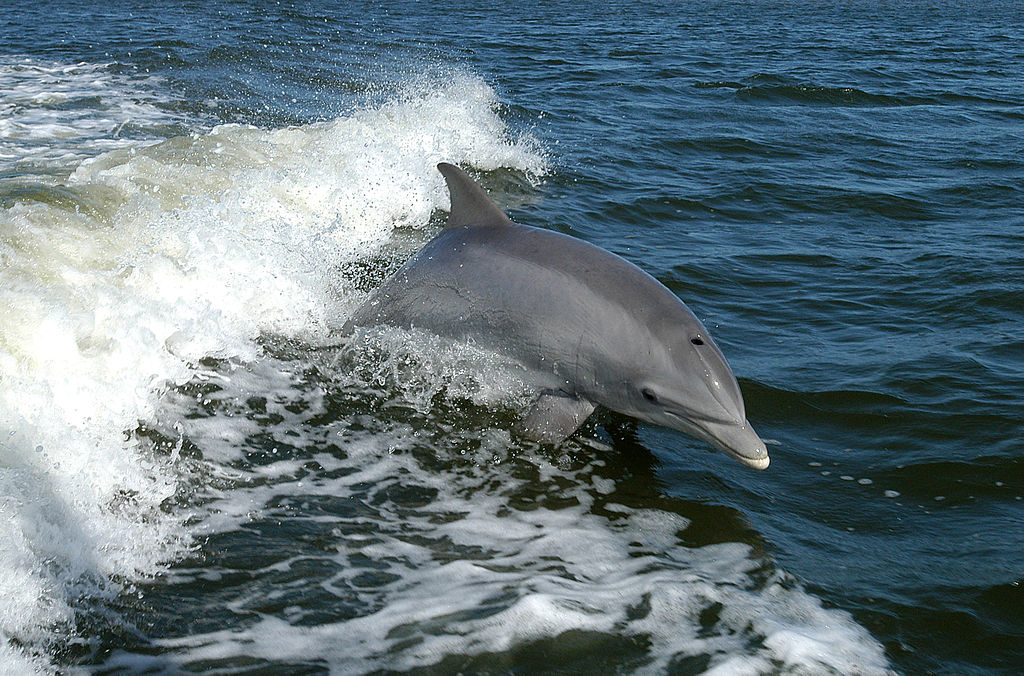Dolphinese: The Idea That Animals Think As We Do Dies Hard
But first it can lead us down strange pathsToday, we can hear trained seals whorfing “Twinkle, Twinkle, Little Star” or the Star Wars theme instead of their native cries. It’s a novelty, like teaching dogs to bark “Jingle Bells.” We recognize a cultural expression; the seal whorfs and the dog barks on cue.
But some science personalities have been quite serious about teaching animals to speak, whether it be elephants, apes—or dolphins. Not only would their success help to establish that humans are just animals but it might help us communicate with extraterrestrials. That is how a dolphin got swept up with SETI, Carl Sagan, the Drake Equation, and LSD into a science celeb dolphin cult. Dolphin intelligence became a theme in popular science culture (“So long and thanks for all the fish”) but the public interest didn’t turn out well for the dolphins.

The legendary skeptical astronomer Carl Sagan (1934–1996) was a believer:
In 1961, the great scientist Carl Sagan joined a semi-secret society called the Order of the Dolphin, which hoped to establish communication with intelligent extraterrestrials. Among the society’s members was a neuroscientist named John Lilly, who had made a name for himself popularizing the idea that dolphins have their own language, as well as a kind of super-intelligence that rivals our own. Crack the code of dolphinese, argued Lilly, and we will be able to decipher any alien language we might encounter.
The order’s members—including the astrophysicist Frank Drake, the evolutionary biologist J.B.S. Haldane and the Nobel Prize-winning chemist Melvin Calvin—took Lilly’s idea about human-dolphin communication quite seriously. As the Princeton historian D. Graham Burnett has noted, they wore insignia shaped like bottlenose dolphins and sent each other coded messages to hone their dolphinese and alien-language-decoding skills.
Justin Gregg, “Dolphins Aren’t as Smart as You Think” (December 18, 2013) at Wall Street Journal
Let’s go back to the start. Impressed as early as 1949 by the sheer size of the dolphin’s brain, American physician neuroscientist John C. Lilly (1915–2001) was convinced that dolphins could learn to communicate at a human level. Indeed, he thought they were possibly “just as intelligent as humans.” At the time, sheer brain size was thought to correlate with intelligence in a way that is now doubted. In 1960 he founded the Communication Research Institute on St. Thomas in the Virgin Islands, with the goal of establishing intelligent interspecies communication with dolphins.
Lilly’s 1961 Man and Dolphin, outlining his theories of interspecies communication, became a bestseller. Frank Drake, developer of the Drake Equation for do-it-yourself estimation of ET life (also publicized in 1961), read it and was impressed. He arranged for funding for Lilly’s lab work from NASA. NASA and other government sources continued funding it during the 1960s.
The Green Bank Conference (1961), to which Lilly introduced “Dolphinese,” was a serious science meeting. The conferees were “totally enthralled” by the idea that communicating with dolphins would open to door to communicating with innumerable types of extraterrestrial intelligence:
In 1961, the National Academy of Sciences organized a meeting on the search for extraterrestrial intelligence (SETI) at the National Radio Astronomy Observatory in Green Bank, West Virginia. The ten scientists who attended, including future SETI icons such as Frank Drake and Carl Sagan, represented a variety of scientific fields. At the conclusion of the meeting, the attendees adopted the moniker “The Order of the Dolphin,” in honor of participant John Lilly’s work on interspecies communication. (01, 2016)
Maria Temming, Maria and Anthony Crider, “ The Order of the Dolphin: Origins of SETI” at American Astronomical Society, AAS Meeting #227, id.114.01
Lilly also published a paper in Science later that year: “Vocal Exchanges between Dolphins: Bottlenose dolphins “talk” to each other with whistles, clicks, and a variety of other noises” (paywall).
Later, intense efforts to crack “Dolphinese” took a controversial turn. In 1965, Lilly’s 23-year-old research assistant Margaret Howe Lovatt lived with a dolphin:
For 10 weeks, from June to August 1965, the St Thomas research centre became the site of Lilly’s most notorious and highly criticized experiment, when his young assistant, Margaret Howe, volunteered to live in confinement with Peter, a bottlenose dolphin. The dolphin house was flooded with water and redesigned for a specific purpose: to allow the 23-year-old Howe and the dolphin to live, sleep, eat, wash and play intimately together. The objective of the experiment was to see whether a dolphin could be taught human speech – a hypothesis that Lilly, in 1960, predicted could be a reality “within a decade or two.”
Even dolphin experts who today hold some of Lilly’s other work in high regard believe it was deeply misguided. Media coverage at the time focused on two things: Howe’s almost total failure to teach Peter to speak; and the reluctant sexual relationship she began with the animal in an effort to put him at his ease. She has not spoken about her experiences for nearly 50 years (to “let [the story] fade”), but earlier this year accepted an interview request by the BBC producer Mark Hedgecoe, who thought it was “the most remarkable story of animal science I had ever heard.”
“In 1965, a young woman lived in isolation with a male dolphin in the name of science. It got weird” at National Post
In 2014, Lovatt broke her silence on this matter and the result was the documentary, The Girl Who Talked to Dolphins.
Also, in 1964, Lilly had started feeding the dolphins LSD (he had been introduced to it by the wife of the producer of dolphin-themed movie Flipper (1963). He developed a dependency himself which alienated colleagues and may have compromised his research.
There was also the vivisection:
In a telling review of Lilly’s Man and Dolphin, a book published just before the Green Bank Conference: “In being so frank about his early failures, his treatment of dolphins, and his personal sacrifices, it may be questioned whether he has not done his cause a disservice,” Bull wrote, highlighting Lilly’s unfortunate tendency to vivisect his dolphins in the course of his research. In retrospect, his review of Lilly’s ethically suspect research methods was remarkably prescient—but no one could predict just how weird things were about to get.
Daniel Oberhaus, “How dolphins on lsd shaped the search for extraterrestrial intelligence” at Supercluster (July 7, 2019)
We are told, in Lilly’s defense, that he was “unable to sedate dolphins, as they stop breathing under anaesthetic.”
But vivisect? “Vivisect” and “Flipper” don’t seem to belong in the same sentence.

Carl Sagan dropped by now and then, to encourage the pursuit of Dolphinese. But no one, not even the dolphins, seemed able to manage it. The fact that, in 1970, Hustler got hold of the sex angle did not help with presenting the floundering experiment as serious research. Meanwhile, a darker problem emerged. As with experiments that attempt to make great apes into near-humans, the dolphin experiment itself proved cruel to dolphins:
Lab director Gregory Bateson left, due to “Lilly’s cavalier attitude to the dolphins’ welfare.” Lab funding was cut 1966, just after the live-with-a-dolphin experiment had ended. But what became of the dolphin?
Without funding, the fate of the dolphins was in question. “I couldn’t keep Peter,” says Lovatt, wistfully. “If he’d been a cat or a dog, then maybe. But not a dolphin.” Lovatt’s new job soon became the decommissioning of the lab and she prepared to ship the dolphins away to Lilly’s other lab, in a disused bank building in Miami. It was a far cry from the relative freedom and comfortable surroundings of Dolphin House.
At the Miami lab, held captive in smaller tanks with little or no sunlight, Peter quickly deteriorated, and after a few weeks Lovatt received news.
“I got that phone call from John Lilly,” she recalls. “John called me himself to tell me. He said Peter had committed suicide.”
Ric O’Barry corroborates the use of this word. “Dolphins are not automatic air-breathers like we are,” he explains. “Every breath is a conscious effort. If life becomes too unbearable, the dolphins just take a breath and they sink to the bottom. They don’t take the next breath.” Andy Williamson puts Peter’s death down to a broken heart, brought on by a separation from Lovatt that he didn’t understand. “Margaret could rationalise it, but when she left, could Peter? Here’s the love of his life gone.”
Christopher Riley, “The dolphin who loved me: the Nasa-funded project that went wrong” at The Guardian
Whatever had happened to Peter, teaching dolphins to use human-like languages is no longer the active research effort it was back then, though dolphin communications are still studied:
The real-life Dr Doolittles have identified nearly 200 distinct whistles and clicks made by dolphins in the wild – and say they know what half a dozen mean.
The findings highlight once again the intelligence of dolphins, and how humans may not have a monopoly on intelligent conversation.
David Derbyshire, “Scientists who studied ‘dolphinese’ claim they are closer to humans than we thought” at Daily Mail (December 20, 2007)
But today such claims for human-like languages among animals tend to be hedged by qualification and problematizing:
Since Lilly’s initial experiments, researchers have found that a number of species communicate using something that approaches the complexity of human language. Whether it is appropriate to characterize animal communication systems as “languages,” in the same way that English or Mandarin are languages, is a matter of debate. The crux of the debate centers on defining just what constitutes human language. Whether dolphins have a language like English or Mandarin is, we are told, a matter of debate.
Daniel Oberhaus, “Dolphins Are Helping Us Hunt for Aliens” at Nautilus (May 6, 2018)
Actually, it would be a matter of debate only if we had reason to believe that language use was under discussion among the dolphins. But it doesn’t look as though dolphins have ever needed to say much beyond the whistles and clicks.
Among humans, by contrast, a small literary legacy survives:
In the 1980s Lilly directed a project which attempted to teach dolphins a computer-synthesised language. Lilly’s work, with dolphins and the development of the sensory deprivation tank, has been referenced in movies, music and television productions. “Dolphin Island: A Story of the People of the Sea” is a 1963 novel by Arthur C. Clarke set in a strange and fascinating research community where a brilliant professor tries to communicate with dolphins. In the 1973 movie, The Day of the Dolphin, George C. Scott portrayed a Lilly-esque scientist, known to the dolphins as “Pa.” who succeeded in teaching a dolphin to speak elementary English. The 1980 movie, Altered States features actor William Hurt regressing to a simian form by the combination of ingesting psychoactive substances and submersion in a sensory deprivation chamber.
– the book page for Man and Dolphin at Amazon
There is still no evidence-based reason to believe that any non-human life form—great apes, elephants, or dolphins—can be coached by humans to think in abstractions, as rational beings. Recognizing that fact may help us avoid inflicting needless cruelty in the future.
Further reading on science-based efforts to get animals to use language as humans do:
The real reason why only human beings speak. Language is a tool for abstract thinking—a necessary tool for abstraction—and humans are the only animals who think abstractly (Michael Egnor)
Elephants who fly—or become “persons”—are magic. Okay, it’s impossible. But then why do thinkers who don’t believe the one believe the other? For decades, researchers were transfixed with the idea of humanizing great apes by raising them among humans and teaching them language. Emerging from the ruins and recriminations of the collapse, philosophy prof Don Ross has a new idea: Let’s start with elephants instead.
and
Researchers: Apes are just like us. And we’re not doing the right things to make them start behaving that way… In 2011, we were told in Smithsonian Magazine, “‘Talking’ apes are not just the stuff of science fiction; scientists have taught many apes to use some semblance of language.” Have they? If so, why has it all subsided? What happened?
